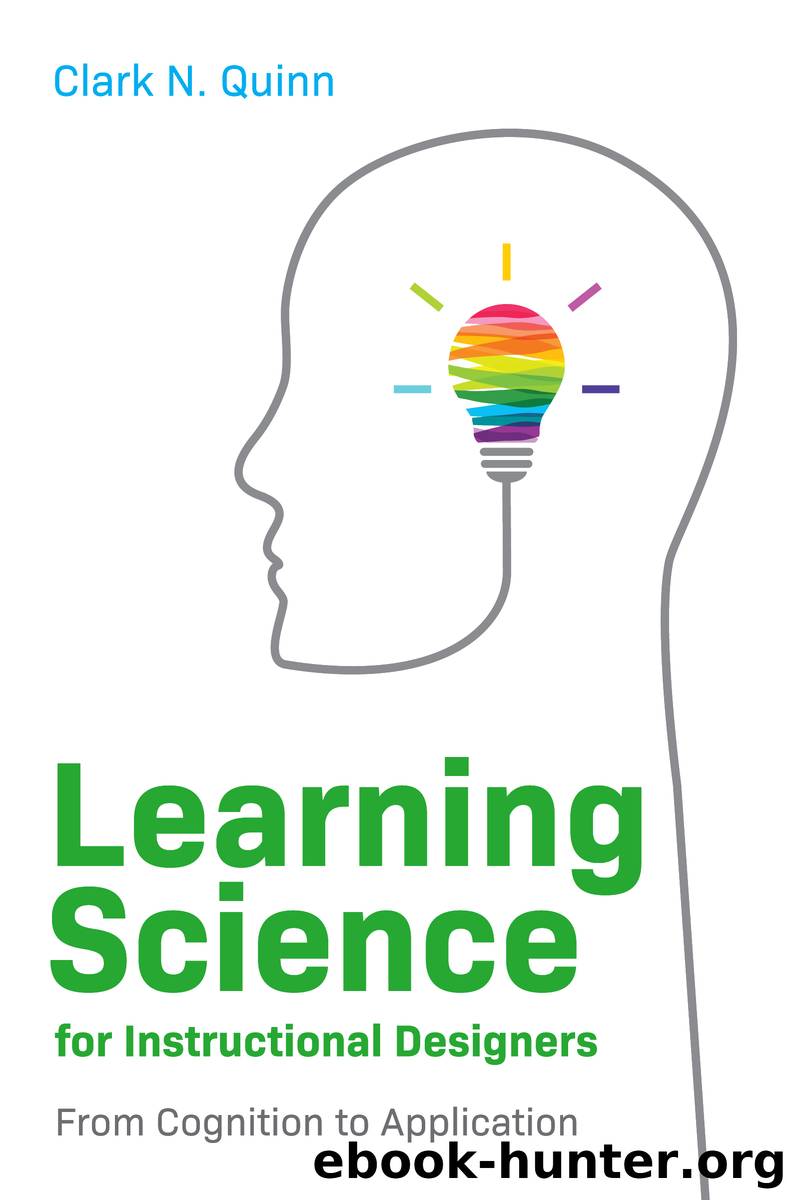Learning Science for Instructional Designers by Clark N. Quinn

Author:Clark N. Quinn [Clark N. Quinn]
Language: eng
Format: epub
Publisher: Association for Talent Development
Published: 2021-03-17T16:00:00+00:00
Figure 5-1. HEXACO Model
Elementary, My Dear Engagement
Thereâs robust evidence that things that evoke a strong emotional response are remembered better. To that point, in Nick Shackleton-Jonesâs book How People Learn, he posits that we remember only the emotional component. While thatâs an unlikely extension, it does make the point that we should make people care.
And, to be clear, engagement is a function of the elements weâre talking about. Motivation, lack of anxiety, challenge, and more work together to create an experience thatâs compelling.
Engagement is complex. Thereâs not even agreement about what are the core emotions. Yet, we know that there are positives and negatives. That is, some emotions are unpleasant (though sometimes we might indulge them), and some are pleasant (which weâre more likely to seek).
At core, engagement involves more than the nervous system. Chemicals are emitted in tune with the triggers of our emotional state, and carry the messages. As a consequence, for instance, the long-term effects of negative emotions, such as stress, can actually damage the body.
Donald Norman, in his book Emotional Design, documented some elements of negative and positive emotions as well as the associated impacts on cognition. Not surprisingly, we are more open to explore, more divergent, and more relaxed when the emotional space was positive. Interestingly, we tend to dig deeper when the emotional environment was negative.
This isnât surprising, because under stress, weâre likely to decrease our ability to marshal many cognitive resources, and will likely work hard in one area. At least initially, then, you want to keep the atmosphere positive. If our long-term goal is to be able to perform in stressful situations, that may end up being part of the experience design, but Iâll suggest that getting the responses down before ramping up the pressure makes sense.
Anxiety
The negative reaction can be seen as a result of a core emotion, anxiety. Here Iâm not talking about the general emotional state, but instead a specific dread of an anticipated learning experience. If we think things will go bad, itâs certainly possible for anxiety to interfere with other events up to and including the dreaded one.
Learning certainly can spawn anxiety. If we believe the stakes are high, we might worry that we will not succeed. Our performance isnât as consistent as weâd like, and our architecture includes making mistakes occasionally. Stress can make that worse. Thus, if thereâs too much riding on one outcome, anxiety can interfere.
It turns out, according to research represented by the Yerkes-Dodson law, that a bit of arousal (read: stress or anxiety) increases performance (Figure 5-2). The question, of course, is how much is âa bit.â Depending on your self-esteem, feeling of satisfactory practice, general even-headedness (such as low neuroticism on the OCEAN scale), and so on, you might go past the optimal level very quickly.
Our goal, then, should be to control anxiety and ensure that itâs low enough to support learning. Weâll address this more under culture, but in short we want the consequences of learning to not be too onerous compared with the benefits.
Download
This site does not store any files on its server. We only index and link to content provided by other sites. Please contact the content providers to delete copyright contents if any and email us, we'll remove relevant links or contents immediately.
The Data Detective by Tim Harford(1115)
100 Tricks to Appear Smart in Meetings by Sarah Cooper(816)
Mind Management, Not Time Management by David Kadavy(773)
GMAT For Dummies 2021 by Lisa Zimmer Hatch & Scott A. Hatch(708)
99 Financial Terms Every Beginner, Entrepreneur & Business Should Know (Financial IQ Series Book 1) by Herold Thomas(675)
Amazing Decisions by Dan Ariely(655)
The Smart Strategy Book by Kevin Duncan(542)
The Data Science Framework by Unknown(521)
The Store Detective Training Manual: A Practical Reference for Current and Aspiring Loss Prevention Officers by Glen Canarte(458)
Poor Students, Rich Teaching by Eric Jensen(442)
Cambridge IGCSE and O Level Business Studies by Karen Borrington(427)
Arts, Sciences, and Economics by Tönu Puu(424)
Robert's Rules of Order by Henry M. Robert(421)
Enterprise Analytics by Thomas H. Davenport(415)
Sustainable Education and Development by Unknown(409)
97 Things Every Information Security Professional Should Know by Christina Morillo(400)
Side Hustles: How to Make Extra Money Online by Hayden Vernon(391)
Excel 2016 for Marketing Statistics by Thomas J. Quirk & Eric Rhiney(377)
Information Literacy in Higher Education by unknow(362)
